Evaluation of Mechanical, Ecological, Economical, and Thermal Characteristics of Geopolymer Concrete Containing Processed Slag Sand
Abstract
:1. Introduction
Motivation, Objective, and Scope of the Study
2. Materials and Methods
2.1. Physical Characteristics and Mixture Proportion
2.2. Mixing, Placing and Curing of Specimens
2.3. Tests on Hardened Concrete
3. Results and Discussion
3.1. Micrographs of PQGRS and PQGSx
3.2. Mechanical Strengths of PQGRS and PQGSx Mixes
3.3. Ecological and Cost Analysis of PQGRS and PQGSx Mixes
3.3.1. Operational Unit and System Boundaries
3.3.2. Estimation of Embodied Energy (EE) of PQGRS and PQGSx Mixes
3.3.3. Estimation of Carbon Dioxide Emissions from PQGRS and PQGSx Mixes
3.3.4. Cost Analysis of PQGRS and PQGSx Mixes
3.3.5. Eco-Efficiency (EcoE) of PQGRS and PQGSx Mixes
3.3.6. Impact Assessment of PQGRS and PQGSx Mixes
3.3.7. Global Warming Potential of PQGRS and PQGSx Mixes
3.3.8. Effect of Reduced Thermal Conductivity (TC) and Surface Temperature on the Environment
4. Conclusions
- The mix with 100% PSS improved the microstructure due to the maximum synthesis of fly ash and slag particles, thus refining the pore structure and producing a denser matrix. PSS also enhanced the mechanical strength properties of PQGC mixes.
- The embodied energy and CO2 emission potential of all PQGC mixes remained substantially lower than PQC and FPQC, underscoring the environmental friendliness of PQGC.
- PQGC mixes were 23% to 35% more expensive than conventional PQC and FPQC due to the high cost of alkaline liquids used in PQGC production. However, the price could be reduced by subsidizing alkaline liquids. The 100% replacement of RSa by PSS marginally reduced the cost of PQGC by 6.4%.
- The global warming potential of all PQGC mixes was similar and nearly 50% lower than that of PQC and FPQC, indicating that PQGC, particularly with PSS, contributes less to environmental warming.
- PQGRS, which contained RSa, had the highest thermal conductivity, retaining more heat throughout the day and night. In contrast, the presence of PSS in PQGC reduced its thermal conductivity, resulting in lower heat conduction and faster cooling, thus remaining relatively cooler and mitigating the heat island effect. In summary, comparing the results of PQGS4 and PQGRS, it is evident that PSS is an economical, eco-friendly, and sustainable alternative to river sand.
Author Contributions
Funding
Institutional Review Board Statement
Informed Consent Statement
Data Availability Statement
Acknowledgments
Conflicts of Interest
References
- Manjunatha, M.; Preethi, S.; Malingaraya; Mounika, H.; Niveditha, K.; Ravi. Life cycle assessment (LCA) of concrete prepared with sustainable cement-based materials. Mater. Today Proc. 2021, 47, 3637–3644. [Google Scholar] [CrossRef]
- Alsalman, A.; Assi, L.N.; Kareem, R.S.; Carter, K.; Ziehl, P. Energy and CO2 emission assessments of alkali-activated concrete and Ordinary Portland Cement concrete: A comparative analysis of different grades of concrete. Clean. Environ. Syst. 2021, 3, 100047. [Google Scholar] [CrossRef]
- Oyebisi, S.; Olutoge, F.; Kathirvel, P.; Oyaotuderekumor, I.; Lawanson, D.; Nwani, J.; Ede, A.; Kaze, R. Sustainability assessment of geopolymer concrete synthesized by slag and corncob ash. Case Stud. Constr. Mater. 2022, 17, e01665. [Google Scholar] [CrossRef]
- Fernando, S.; Gunasekara, C.; Law, D.W.; Nasvi, M.C.M.; Setunge, S.; Dissanayake, R. Life cycle assessment and cost analysis of fly ash–rice husk ash blended alkali-activated concrete. J. Environ. Manag. 2021, 295, 113140. [Google Scholar] [CrossRef]
- Bianco, I.; Tomos, B.A.D.; Vinai, R. Analysis of the environmental impacts of alkali-activated concrete produced with waste glass-derived silicate activator—A LCA study. J. Clean. Prod. 2021, 316, 128383. [Google Scholar] [CrossRef]
- Das, B.B.; Sudhi, A.; Pandey, D. Pozzolanic Reactivity, Hydration and Microstructure Characteristics of Blended Cementitious Composites Comprising of Ultrafine Particles. Iran. J. Sci. Technol.—Trans. Civ. Eng. 2022, 46, 4187–4204. [Google Scholar] [CrossRef]
- Kudva, L.P.; Nayak, G.; Shetty, K.K.; Sugandhini, H.K. Mechanical Properties of Fiber-Reinforced High-Volume Fly-Ash-Based Cement Composite—A Long-Term Study. Sustainability 2023, 15, 13128. [Google Scholar] [CrossRef]
- Srividya, T.; Rajkumar, P.R.K.; Sivasakthi, M.; Sujitha, A.; Jeyalakshmi, R. A state-of-the-art on development of geopolymer concrete and its field applications. Case Stud. Constr. Mater. 2022, 16, e00812. [Google Scholar] [CrossRef]
- Girish, M.G.; Shetty, K.K.; Nayak, G. Effect of Slag Sand on Mechanical Strengths and Fatigue Performance of Paving Grade Geopolymer Concrete. Int. J. Pavement Res. Technol. 2023. [Google Scholar] [CrossRef]
- Verma, M.; Dev, N.; Rahman, I.; Nigam, M.; Ahmed, M.; Mallick, J. Geopolymer Concrete: A Material for Sustainable Development in Indian Construction Industries. Crystals 2022, 12, 514. [Google Scholar] [CrossRef]
- Siyal, A.A.; Mohamed, R.M.S.R.; Shamsuddin, R.; Ridzuan, M.B. A comprehensive review of synthesis kinetics and formation mechanism of geopolymers. RSC Adv. 2024, 14, 446–462. [Google Scholar] [CrossRef]
- Gebregziabiher, B.S.; Thomas, R.; Peethamparan, S. Very early-age reaction kinetics and microstructural development in alkali-activated slag. Cem. Concr. Compos. 2015, 55, 91–102. [Google Scholar] [CrossRef]
- Wang, H.; Zhao, X.; Wang, T.; Su, L.; Zhou, B.; Lin, Y. Determination of Gel Products in Alkali-Activated Fly Ash-Based Composites Incorporating Inorganic Calcium Additives. Adv. Mater. Sci. Eng. 2022, 2022, 7476671. [Google Scholar] [CrossRef]
- Qaidi, S.; Najm, H.M.; Abed, S.M.; Ahmed, H.U.; Al Dughaishi, H.; Al Lawati, J.; Sabri, M.M.; Alkhatib, F.; Milad, A. Fly Ash-Based Geopolymer Composites: A Review of the Compressive Strength and Microstructure Analysis. Materials 2022, 15, 7098. [Google Scholar] [CrossRef]
- Kamath, M.; Prashant, S.; Ralegaonkar, R. Microstructure Properties of Popular Alkali-Activated Pastes Cured in Ambient Temperature. Buildings 2023, 13, 858. [Google Scholar] [CrossRef]
- Garcia-Lodeiro, I.; Palomo, A.; Fernández-Jiménez, A.; MacPhee, D.E. Compatibility studies between N-A-S-H and C-A-S-H gels. Study in the ternary diagram Na2O-CaO-Al2O3-SiO2-H2O. Cem. Concr. Res. 2011, 41, 923–931. [Google Scholar] [CrossRef]
- Frasson, B.J.; Rocha, J.C. Reaction mechanism and mechanical properties of geopolymer based on kaolinitic coal tailings. Appl. Clay Sci. 2023, 233, 106826. [Google Scholar] [CrossRef]
- Wan, Q.; Rao, F.; Song, S.; García, R.E.; Estrella, R.M.; Patiño, C.L.; Zhang, Y. Geopolymerization reaction, microstructure and simulation of metakaolin-based geopolymers at extended Si/Al ratios. Cem. Concr. Compos. 2017, 79, 45–52. [Google Scholar] [CrossRef]
- Saif, M.S.; El-Hariri, M.O.R.; Sarie-Eldin, A.I.; Tayeh, B.A.; Farag, M.F. Impact of Ca+ content and curing condition on durability performance of metakaolin-based geopolymer mortars. Case Stud. Constr. Mater. 2022, 16, e00922. [Google Scholar] [CrossRef]
- Mehta, A.; Siddique, R.; Ozbakkaloglu, T.; Shaikh, F.U.A.; Belarbi, R. Fly ash and ground granulated blast furnace slag-based alkali-activated concrete: Mechanical, transport and microstructural properties. Constr. Build. Mater. 2020, 257, 119548. [Google Scholar] [CrossRef]
- Vázquez-Rodríguez, F.; Elizondo, N.; Montes-González, M.; Gómez-Rodríguez, C.; González-Carranza, Y.; Guzmán, A.M.; Rodríguez, E.A. Microstructural and Mechanical Characteristics of Alkali-Activated Binders Composed of Milled Fly Ash and Granulated Blast Furnace Slag with µ-Limestone Addition. Materials 2023, 16, 3818. [Google Scholar] [CrossRef]
- Prasanna, K.M.; Sharath, B.P.; Choukade, H.; Shivaprasad, K.N.; Das, B.B.; Mahesh, G. Research on Setting Time, Compressive Strength and Microstructure of Fly Ash-Based Geopolymer Mixture Containing Slag. Iran. J. Sci. Technol.—Trans. Civ. Eng. 2023, 47, 1503–1517. [Google Scholar] [CrossRef]
- Yu, G.; Jia, Y. Microstructure and Mechanical Properties of Fly Ash-Based Geopolymer Cementitious Composites. Minerals 2022, 12, 853. [Google Scholar] [CrossRef]
- Mohammed, A.A.; Ahmed, H.U.; Mosavi, A. Survey of mechanical properties of geopolymer concrete: A comprehensive review and data analysis. Materials 2021, 14, 4690. [Google Scholar] [CrossRef]
- Abhishek, H.S.; Prashant, S.; Kamath, M.V.; Kumar, M. Fresh mechanical and durability properties of alkali-activated fly ash-slag concrete: A review. Innov. Infrastruct. Solut. 2021, 7, 116. [Google Scholar] [CrossRef]
- Tayeh, B.A.; Hamada, H.M.; Almeshal, I.; Bakar, B.H.A. Durability and mechanical properties of cement concrete comprising pozzolanic materials with alkali-activated binder: A comprehensive review. Case Stud. Constr. Mater. 2022, 17, e01429. [Google Scholar] [CrossRef]
- Fang, G.; Zhang, M. Multiscale micromechanical analysis of alkali-activated fly ash-slag paste. Cem. Concr. Res. 2020, 135, 106141. [Google Scholar] [CrossRef]
- Girish, M.G.; Shetty, K.K.; Nayak, G. Synthesis of Fly-ash and Slag Based Geopolymer Concrete for Rigid Pavement. Mater. Today Proc. 2022, 60, 46–54. [Google Scholar] [CrossRef]
- Junaid, M.T.; Karzad, A.S.; Leblouba, M. Investigation on the properties of ambient cured alkali activated binder concrete. Int. J. Appl. Sci. Eng. 2021, 18, 2020339. [Google Scholar] [CrossRef]
- Li, N.; Shi, C.; Zhang, Z.; Wang, H.; Liu, Y. A review on mixture design methods for geopolymer concrete. Compos. B Eng. 2019, 178, 107490. [Google Scholar] [CrossRef]
- Li, N.; Shi, C.; Zhang, Z.; Zhu, D.; Hwang, H.-J.; Zhu, Y.; Sun, T. A mixture proportioning method for the development of performance-based alkali-activated slag-based concrete. Cem. Concr. Compos. 2018, 93, 163–174. [Google Scholar] [CrossRef]
- Beskopylny, A.N.; Stel’makh, S.A.; Shcherban’, E.M.; Mailyan, L.R.; Meskhi, B.; El’shaeva, D.; Varavka, V. Developing environmentally sustainable and cost-effective geopolymer concrete with improved characteristics. Sustainability 2021, 13, 13607. [Google Scholar] [CrossRef]
- Davidovits, J. Global warming impact on the cement and aggregates industries. World Resour. Rev. 1994, 6, 263–278. [Google Scholar]
- Habert, G.; De Lacaillerie, J.B.D.; Roussel, N. An environmental evaluation of geopolymer based concrete production: Reviewing current research trends. J. Clean. Prod. 2011, 19, 1229–1238. [Google Scholar] [CrossRef]
- Witzleben, S. Minimizing the Global Warming Potential with Geopolymer-Based Insulation Material with Miscanthus Fiber. Polymers 2022, 14, 3191. [Google Scholar] [CrossRef]
- Firdous, R.; Nikravan, M.; Mancke, R.; Vöge, M.; Stephan, D. Assessment of environmental, economic and technical performance of geopolymer concrete: A case study. J. Mater. Sci. 2022, 57, 18711–18725. [Google Scholar] [CrossRef]
- Amari, S.; Darestani, M.; Millar, G.J.; Samali, B.; Strounina, E. Engineering and Life Cycle Assessment (LCA) of Sustainable Zeolite-Based Geopolymer Incorporating Blast Furnace Slag. Sustainability 2024, 16, 440. [Google Scholar] [CrossRef]
- Li, Y.; Shen, J.; Lin, H.; Li, Y. Optimization design for alkali-activated slag-fly ash geopolymer concrete based on artificial intelligence considering compressive strength, cost, and carbon emission. J. Build. Eng. 2023, 75, 106929. [Google Scholar] [CrossRef]
- Anand, J.; Sailor, D.J. Role of pavement radiative and thermal properties in reducing excess heat in cities. Sol. Energy 2022, 242, 413–423. [Google Scholar] [CrossRef]
- Al-Humairi, S.; Alias, A.; Haron, N.; Hassim, S.; Jakarni, F.M. Sustainable pavement: A review on the usage of pavement as a mitigation strategy for UHI. IOP Conf. Ser. Mater. Sci. Eng. 2021, 1075, 012010. [Google Scholar] [CrossRef]
- Vujovic, S.; Haddad, B.; Karaky, H.; Sebaibi, N.; Boutouil, M. Urban Heat Island: Causes, Consequences, and Mitigation Measures with Emphasis on Reflective and Permeable Pavements. CivilEng 2021, 2, 459–484. [Google Scholar] [CrossRef]
- Li, H.; Harvey, J.T.; Holland, T.J.; Kayhanian, M. Erratum: The use of reflective and permeable pavements as a potential practice for heat island mitigation and stormwater management. Environ. Res. Lett. 2013, 8, 049501. [Google Scholar] [CrossRef]
- Lu, Y.; Qin, Y.; Huang, C.; Pang, X. Albedo of Pervious Concrete and Its Implications for Mitigating Urban Heat Island. Sustainability 2023, 15, 8222. [Google Scholar] [CrossRef]
- Pan, F.; Pei, J.; Zhang, G.; Wen, Y.; Zhang, J.; Li, R. Building the cooling roads with high thermal conductivity pavements to relieve urban heat island effect. Constr. Build. Mater. 2022, 346, 128276. [Google Scholar] [CrossRef]
- Yang, J.; Wang, Z.H.; Kaloush, K.E.; Dylla, H. Effect of pavement thermal properties on mitigating urban heat islands: A multi-scale modeling case study in Phoenix. Build. Environ. 2016, 108, 110–121. [Google Scholar] [CrossRef]
- Fhwa. TechBrief: Geopolymer Concrete. 2004. Available online: http://www.geopolymer.org/science/introduction (accessed on 7 June 2024).
- Glasby, T.; Day, J.; Genrich, R.; Aldred, J.; Manager, E. EFC Geopolymer Concrete Aircraft Pavements at Brisbane West Wellcamp Airport. In Proceedings of the Concrete 2015 Conference, Melbourne, Australia, 30 August–2 September 2015. [Google Scholar]
- Girish, M.G.; Shetty, K.K.; Raja, A.R. Self-Consolidating Paving Grade Geopolymer Concrete. IOP Conf. Ser. Mater. Sci. Eng. 2018, 431, 092006. [Google Scholar] [CrossRef]
- Dave, N.; Sahu, V.; Misra, A.K. Development of geopolymer cement concrete for highway infrastructure applications. J. Eng. Des. Technol. 2020, 18, 1321–1333. [Google Scholar] [CrossRef]
- Palankar, N.; Shankar, A.U.R.; Mithun, B.M. Investigations on Alkali-Activated Slag/Fly Ash Concrete with steel slag coarse aggregate for pavement structures. Int. J. Pavement Eng. 2017, 18, 500–512. [Google Scholar] [CrossRef]
- Talkeri, A.; Shankar, A.U.R. Alkali activated slag-fly ash concrete incorporating precious slag as fine aggregate for rigid pavements. J. Traffic Transp. Eng. (Engl. Ed.) 2022, 9, 78–92. [Google Scholar] [CrossRef]
- Palankar, N.; Mithun, B.M.; Ravishankar, A.U. Alkali activated concrete with steel slag aggregate for concrete pavements. Int. J. Eng. Technol. 2018, 7, 818–822. [Google Scholar]
- Mithun, B.M.; Narasimhan, M.C.; Nitendra, P.; Ravishankar, A.U. Flexural Fatigue performance of Alkali Activated Slag Concrete mixes incorporating Copper Slag as Fine Aggregate. Sel. Sci. Pap.—J. Civil. Eng. 2015, 10, 7–18. [Google Scholar] [CrossRef]
- Palankar, N.; Shankar, A.U.R.; Mithun, B.M. Durability studies on eco-friendly concrete mixes incorporating steel slag as coarse aggregates. J. Clean. Prod. 2016, 129, 437–448. [Google Scholar] [CrossRef]
- Palankar, N.; Shankar, A.U.R.; Mithun, B.M. Studies on eco-friendly concrete incorporating industrial waste as aggregates. Int. J. Sustain. Built Environ. 2015, 4, 378–390. [Google Scholar] [CrossRef]
- Palankar, N.; Shankar, A.U.R.; Mithun, B.M. Air-cured Alkali activated binders for concrete pavements. Int. J. Pavement Res. Technol. 2015, 8, 289–294. [Google Scholar] [CrossRef]
- Hou, G.; Yan, Z.; Sun, J.; Naguib, H.M.; Lu, B.; Zhang, Z. Microstructure and mechanical properties of CO2-cured steel slag brick in pilot-scale. Constr. Build. Mater. 2021, 271, 121581. [Google Scholar] [CrossRef]
- Xu, Z.; Yu, L.; Lu, B.; Sun, J.; Liu, Z.; Naguib, H.M.; Hou, G. Aragonite formation induced by triethylene glycol and its enhancement to flexural strength in carbonated rankinite cement. Constr. Build. Mater. 2023, 408, 133514. [Google Scholar] [CrossRef]
- Talkeri, A.H.; Shankar, A.U.R. A study on initial setting time and the mechanical properties of AASC using the PS ball as fine aggregate. Int. J. Pavement Res. Technol. 2019, 12, 659–663. [Google Scholar] [CrossRef]
- IS:1727; Method of Test for Pozzolanic Materials. Bureau of Indian Standards: New Delhi, India, 2018.
- IS 2386; Part I. Method of Test for Aggregate for Concrete. Part I—Particle size and shape. Bureau of Indian Standards: New Delhi, India, 1963.
- IS 2386; Part III. Method of Test for Aggregate for Concrete. Part III—Specific Gravity, Density, Voids, Absorption and Bulking. Bureau of Indian Standards: New Delhi, India, 1963.
- IS 2386; Part IV. Methods of Test for Aggregates for Concrete, Part 4: Mechanical Properties. Bureau of Indian Standards: New Delhi, India, 1963.
- IRC 44; Guidelines for Cement Concrete Mix Design for Pavements. Indian Road Congress: New Delhi, India, 2017.
- IS:516; Part-1/Sec-1. Hardened Concrete—Methods of Test. Bureau of Indian Standards: New Delhi, India, 2021. Available online: www.standardsbis.in (accessed on 7 June 2024).
- IS:3346-1980; Method of the Determination of Thermal Conductivity of Thermal Insulation Materials (Two Slab Guarded Hot Plate Method). Bureau of Indian Standards: New Delhi, India, 1980. Available online: https://ia601000.us.archive.org/35/items/gov.in.is.3346.1980/is.3346.1980.pdf (accessed on 7 June 2024).
- IRC:58-2015; Guidelince for the Design of Plane Jointed Rigid Pavements for Highways, fourth rivision. Indian Road Congress: New Delhi, India, 2015.
- Venkataramu, V.; Reddy, B.V.V. Characteristics of Mortars and Masonry Using Granulated Blast Furnace Slag as Fine Aggregate. J. Mater. Civ. Eng. 2022, 34, 04022060. [Google Scholar] [CrossRef]
- Vibha, V.; Reddy, B.V.V. A Study on Properties of Concrete Made with Processed Granulated Blast Furnace Slag as Fine Aggregate. IOP Conf. Ser. Mater. Sci. Eng. 2020, 829, 012008. [Google Scholar] [CrossRef]
- Salihi, A.; Arpitha, D.; Rajasekaran, C. Suitability study of processed granulated blast furnace slag (PGBS) as fine aggregate replacement in mortar exposed to the marine environment. Mater. Today Proc. 2023, 88, 1–5. [Google Scholar] [CrossRef]
- Sudarshan, V.J.; Arpitha, D.; Kumar, Y.T.T.; Rajasekaran, C.; Puttaswamy, N. Assessment on performance of steel slag and processed granulated blast furnace slag as an alternative for fine aggregate—An assertive review. In Trends in Civil Engineering and Challenges for Sustainability; Springer Science and Business Media Deutschland GmbH: Singapore, 2021; pp. 273–282. [Google Scholar] [CrossRef]
- Arpitha, D.; Rajasekaran, C.; Kappadi, P. Study on Processed Granulated Blast Furnace Slag as a Replacement for Fine Aggregates for the Greener Global Construction. In Lecture Notes in Civil Engineering; Springer Science and Business Media Deutschland GmbH: Singapore, 2023; pp. 809–824. [Google Scholar] [CrossRef]
- Mithun, B.M.; Narasimhan, M.C. Performance of alkali activated slag concrete mixes incorporating copper slag as fine aggregate. J. Clean. Prod. 2016, 112, 837–844. [Google Scholar] [CrossRef]
- Gergely, J.; Ogunro, V.O. Compressive Strength and Embodied Energy Optimization of Fly Ash Based Geopolymer Concrete. 2009. Available online: http://www.flyash.info/ (accessed on 7 June 2024).
- Rajamane, N.P.; Nataraja, M.C.; Jeyalakshmi, R. SPECIAL ISSUE-Future Cements Pozzolanic industrial waste based geopolymer concretes with low carbon footprint. Indian Concr. J. 2014, 88, 49–68. [Google Scholar]
- Hafez, H.; Kurda, R.; Al-Ayish, N.; Garcia-Segura, T.; Cheung, W.M.; Nagaratnam, B. A whole life cycle performance-based ECOnomic and ECOlogical assessment framework (ECO2) for concrete sustainability. J. Clean. Prod. 2021, 292, 126060. [Google Scholar] [CrossRef]
- Turner, L.K.; Collins, F.G. Carbon dioxide equivalent (CO2-e) emissions: A comparison between geopolymer and OPC cement concrete. Constr. Build. Mater. 2013, 43, 125–130. [Google Scholar] [CrossRef]
- Setiawan, A.A.; Hardjasaputra, H.; Soegiarso, R. Embodied carbon dioxide of fly ash based geopolymer concrete. IOP Conf. Ser. Earth Environ. Sci. 2023, 1195, 012031. [Google Scholar] [CrossRef]
- Pratap, B.; Mondal, S.; Rao, B.H. Development of geopolymer concrete using fly ash and phosphogypsum as a pavement composite material. Mater. Today Proc. 2023, 93, 35–40. [Google Scholar] [CrossRef]
- Sandanayake, M.; Gunasekara, C.; Law, D.; Zhang, G.; Setunge, S. Greenhouse gas emissions of different fly ash based geopolymer concretes in building construction. J. Clean. Prod. 2018, 204, 399–408. [Google Scholar] [CrossRef]
- Wudil, Y.S.; Al-Fakih, A.; Al-Osta, M.A.; Gondal, M.A. Intelligent optimization for modeling carbon dioxide footprint in fly ash geopolymer concrete: A novel approach for minimizing CO2 emissions. J. Environ. Chem. Eng. 2023, 12, 111835. [Google Scholar] [CrossRef]
- Tahir, M.F.M.; Abdullah, M.M.A.B.; Rahim, S.Z.A.; Hasan, M.R.M.; Saafi, M.; Jaya, R.P.; Mohamed, R. Potential of industrial By-Products based geopolymer for rigid concrete pavement application. Constr. Build. Mater. 2022, 344, 128190. [Google Scholar] [CrossRef]
- Lima, V.M.E.; Basto, P.A.; Henrique, M.A.; Almeida, Y.M.B.; de Melo Neto, A.A. Optimizing the concentration of Na2O in alkaline activators to improve mechanical properties and reduce costs and CO2 emissions in alkali-activated mixtures. Constr. Build. Mater. 2022, 344, 128185. [Google Scholar] [CrossRef]
- Das, S.; Saha, P.; Jena, S.P.; Panda, P. Geopolymer concrete: Sustainable green concrete for reduced greenhouse gas emission—A review. Mater. Today Proc. 2022, 60, 62–71. [Google Scholar] [CrossRef]
- McLellan, B.C.; Williams, R.P.; Lay, J.; Van Riessen, A.; Corder, G.D. Costs and carbon emissions for geopolymer pastes in comparison to ordinary portland cement. J. Clean. Prod. 2011, 19, 1080–1090. [Google Scholar] [CrossRef]
- Heath, A.; Paine, K.; McManus, M. Minimising the global warming potential of clay based geopolymers. J. Clean. Prod. 2014, 78, 75–83. [Google Scholar] [CrossRef]
- Kumar, M.; Prashant, S.; Kamath, M.V. Enhancing the sustainability of high strength concrete in terms of embodied energy and carbon emission by incorporating sewage sludge and fly ash. Innov. Infrastruct. Solut. 2022, 7, 240. [Google Scholar] [CrossRef]
- Ikotun, J.O.; Aderinto, G.E.; Madirisha, M.M.; Katte, V.Y. Geopolymer Cement in Pavement Applications: Bridging Sustainability and Performance. Sustainability 2024, 16, 5417. [Google Scholar] [CrossRef]
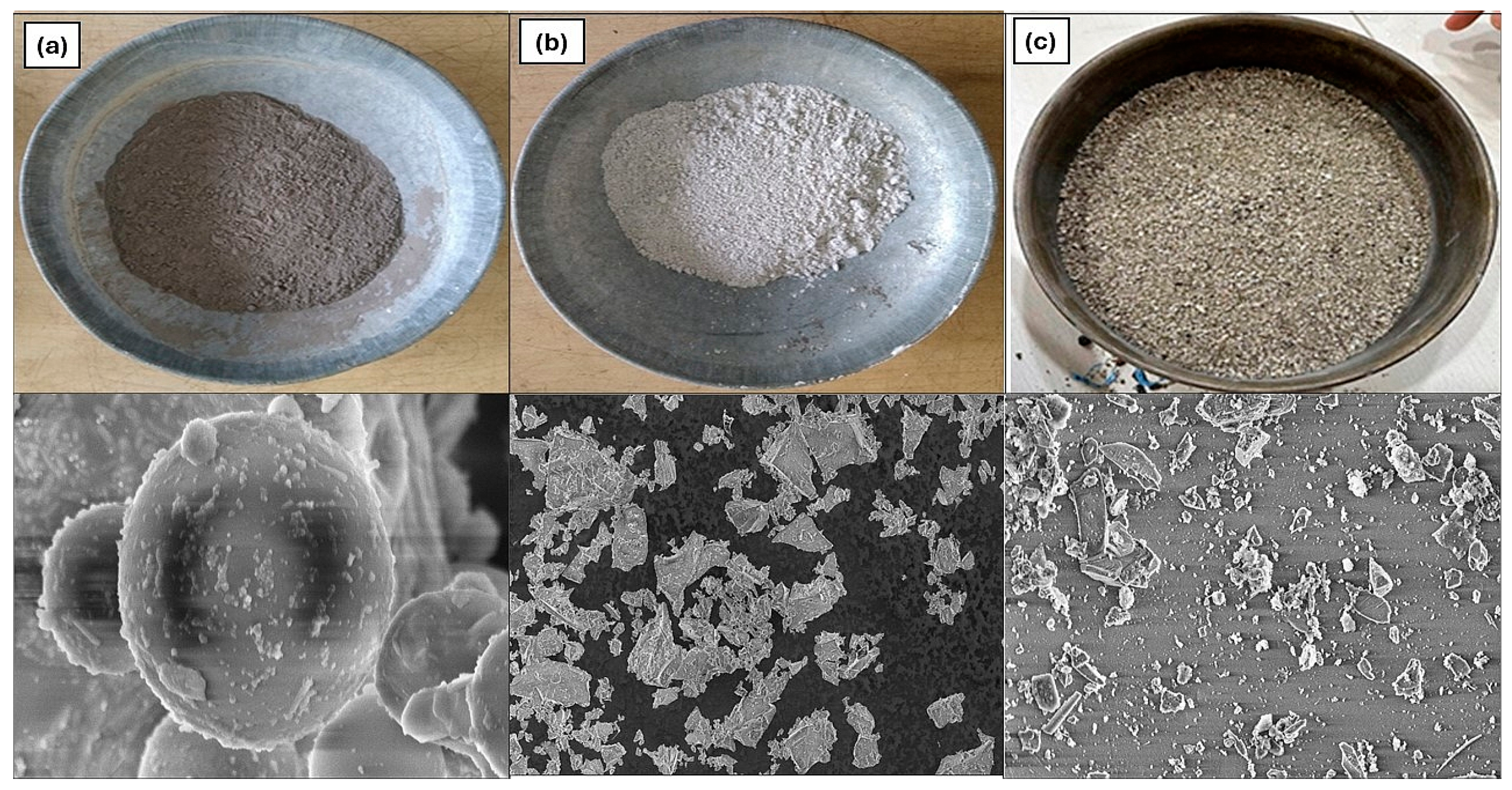
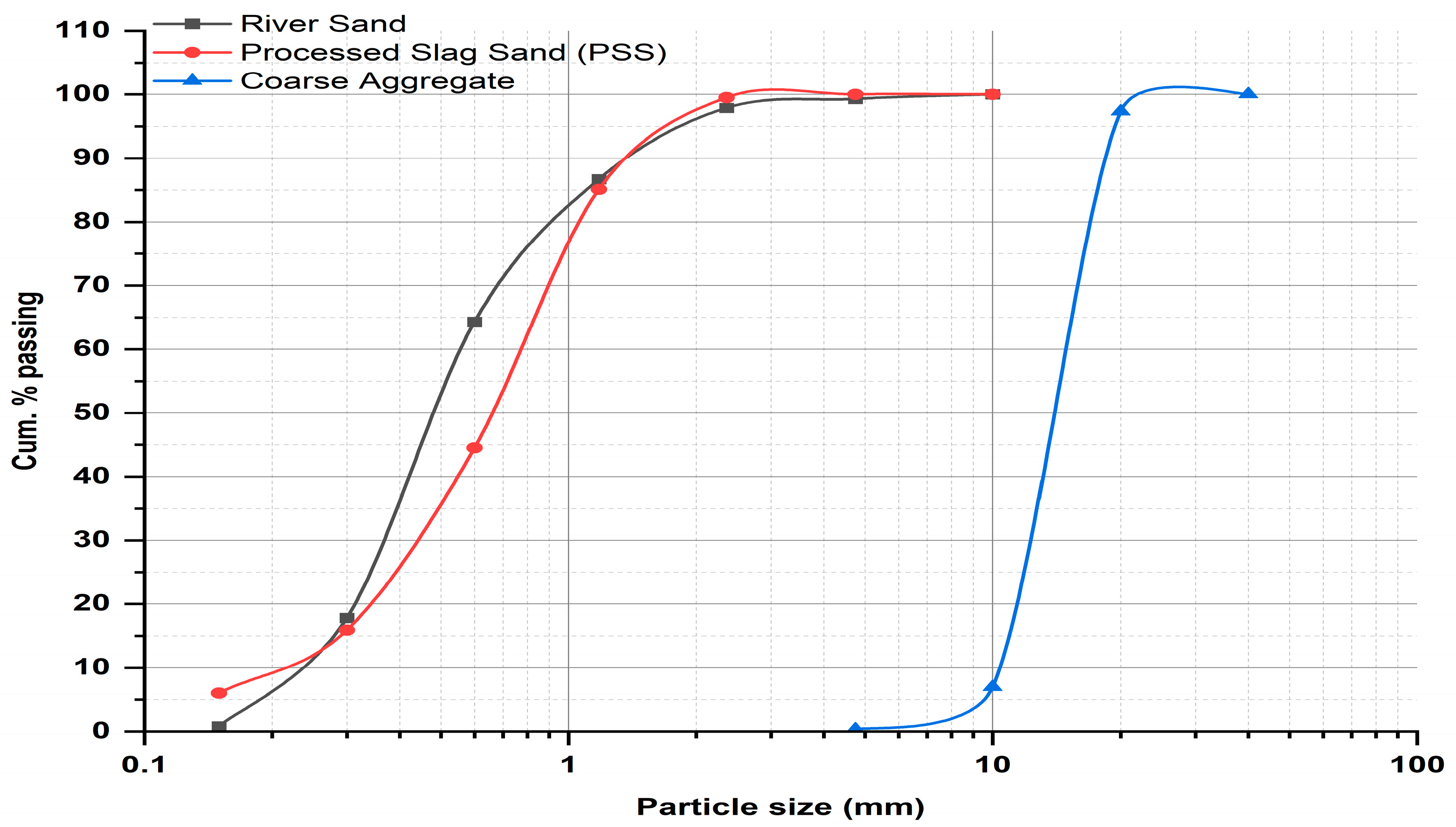
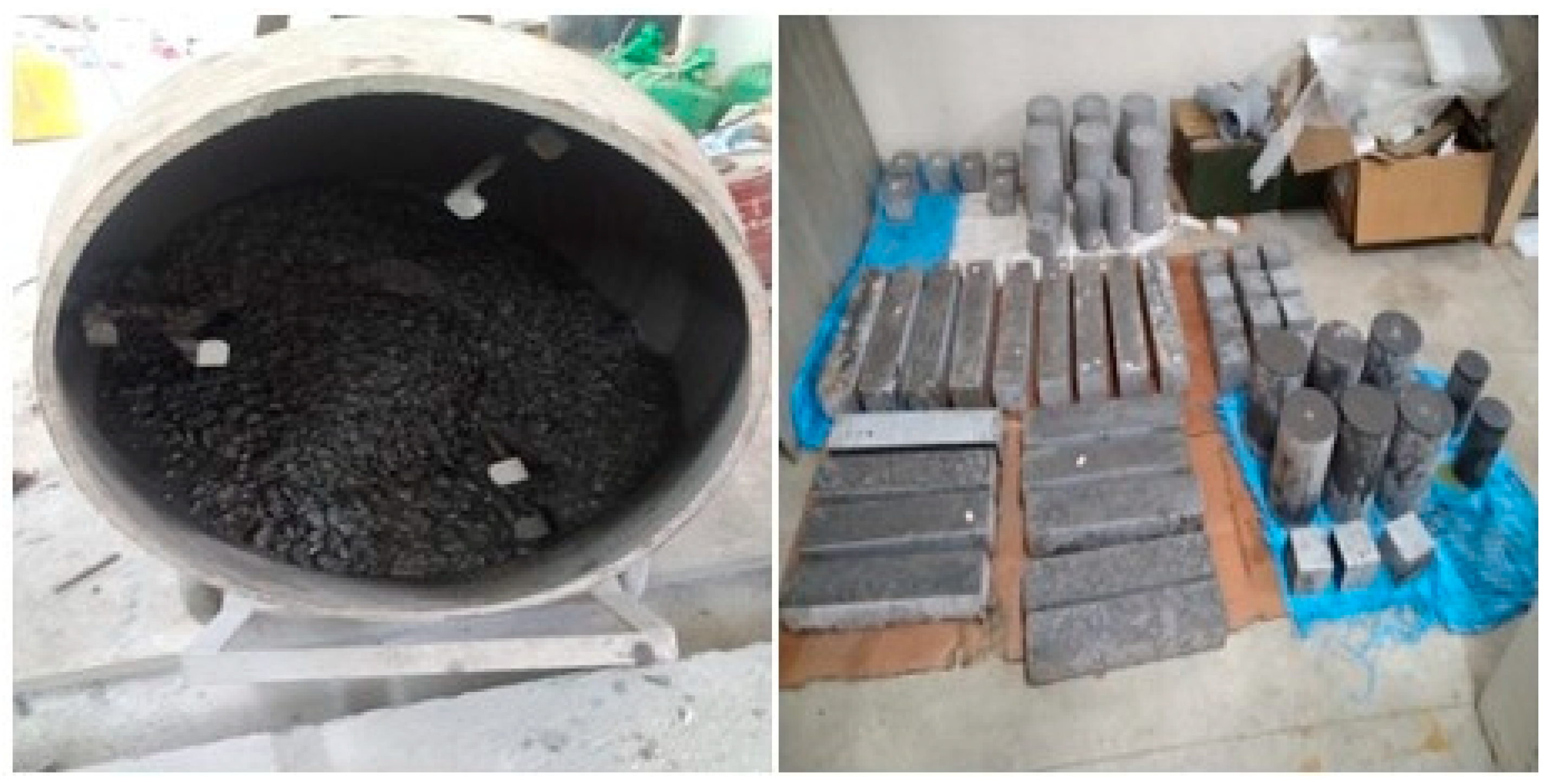

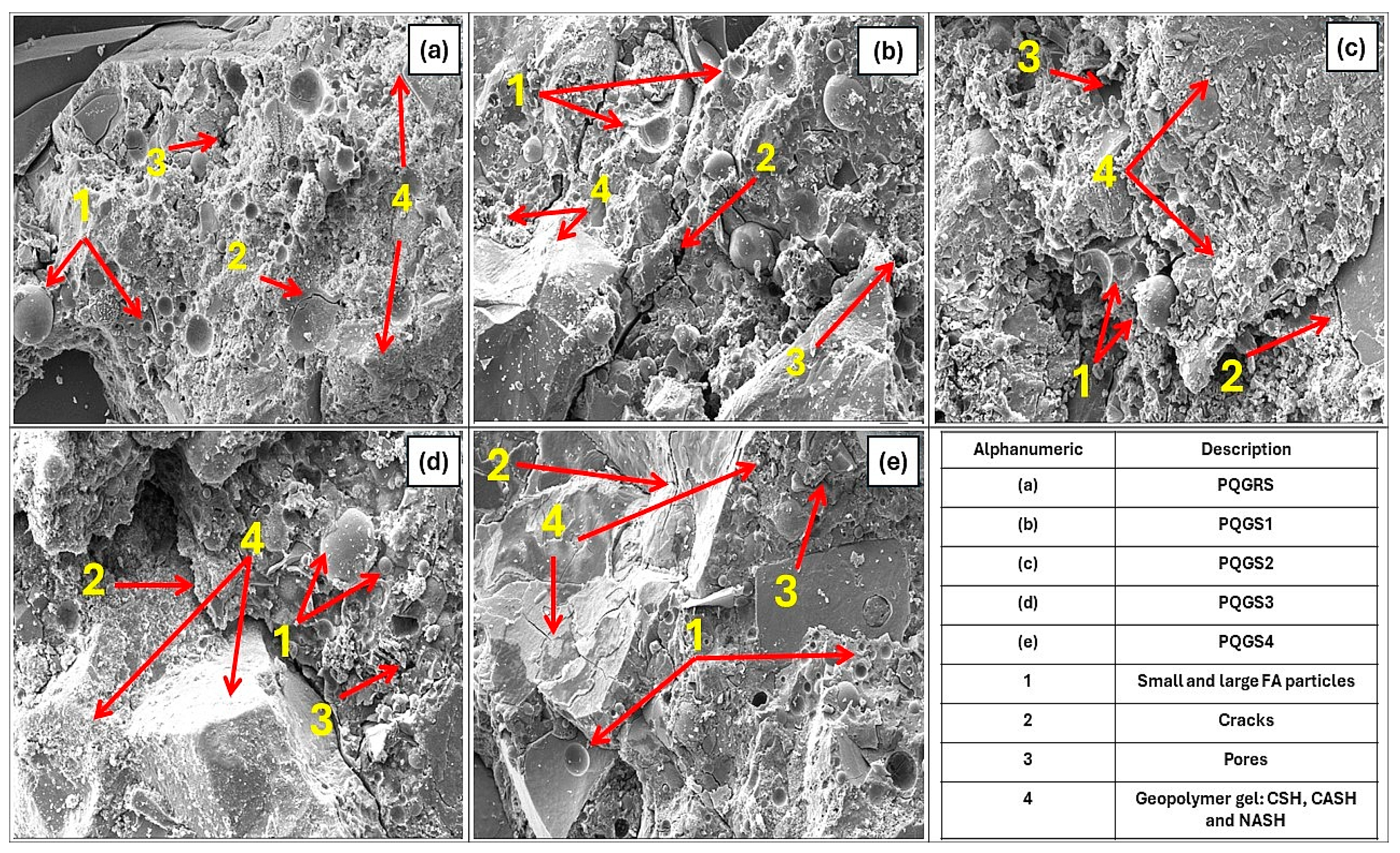
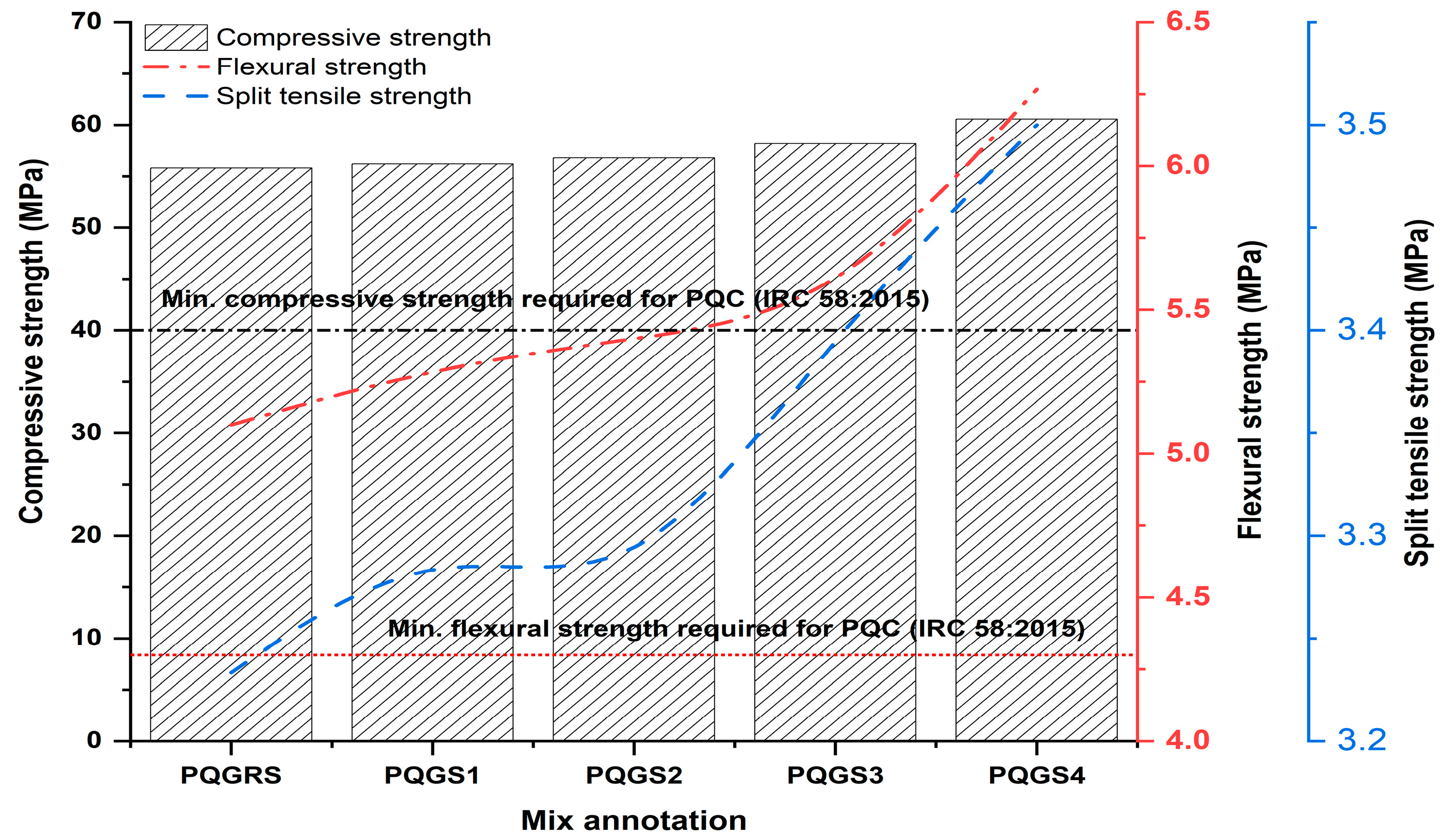

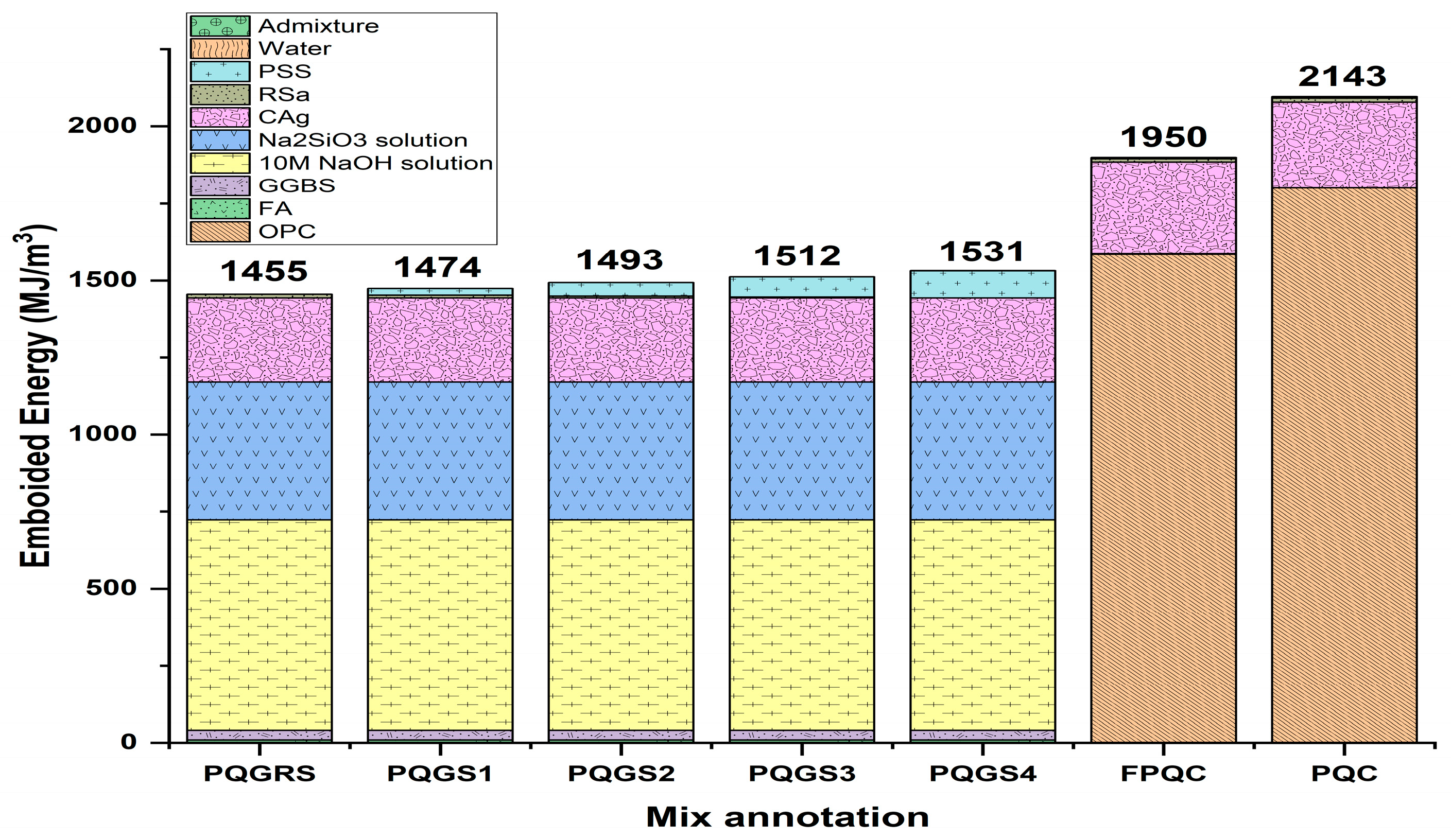


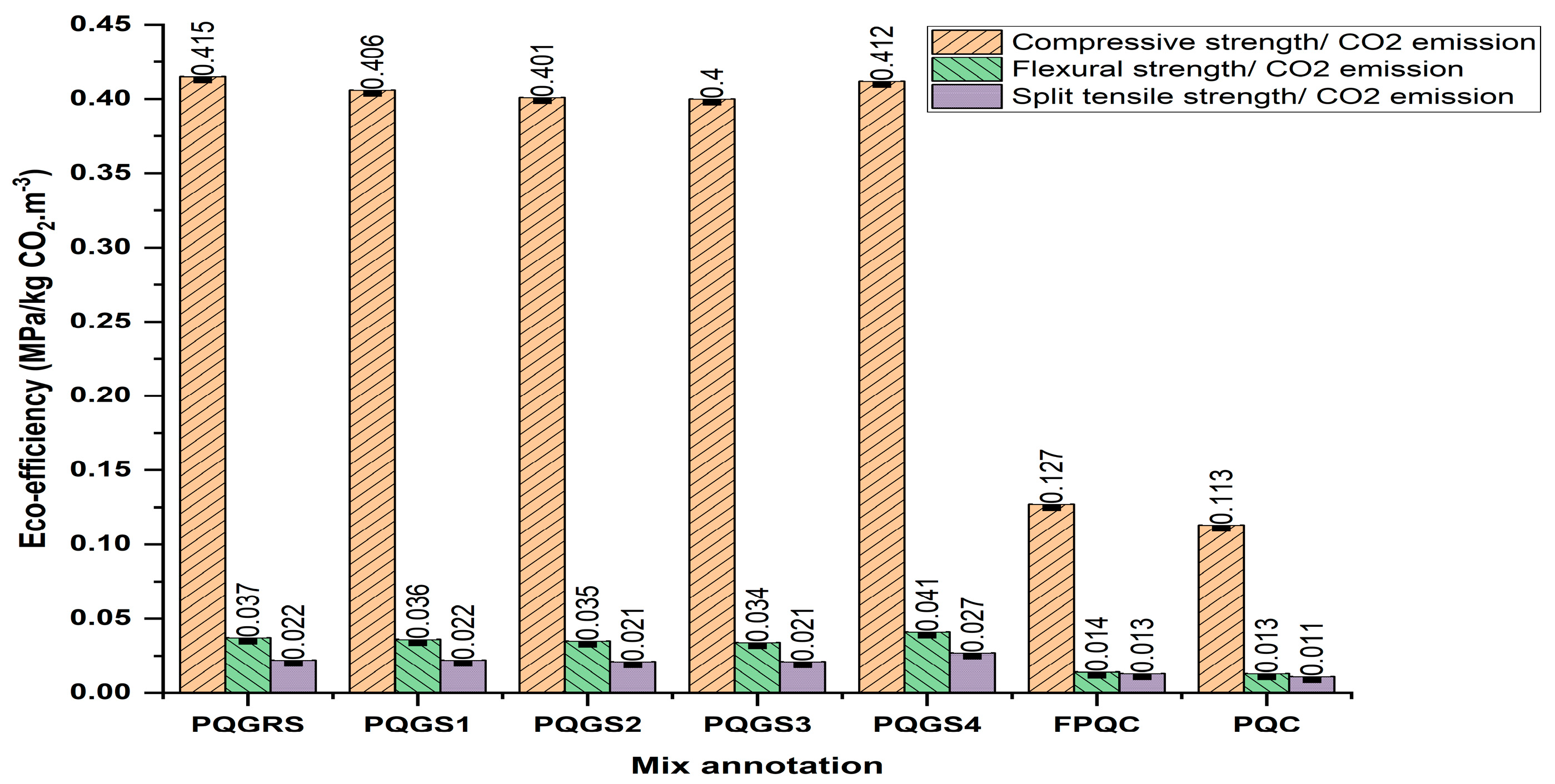
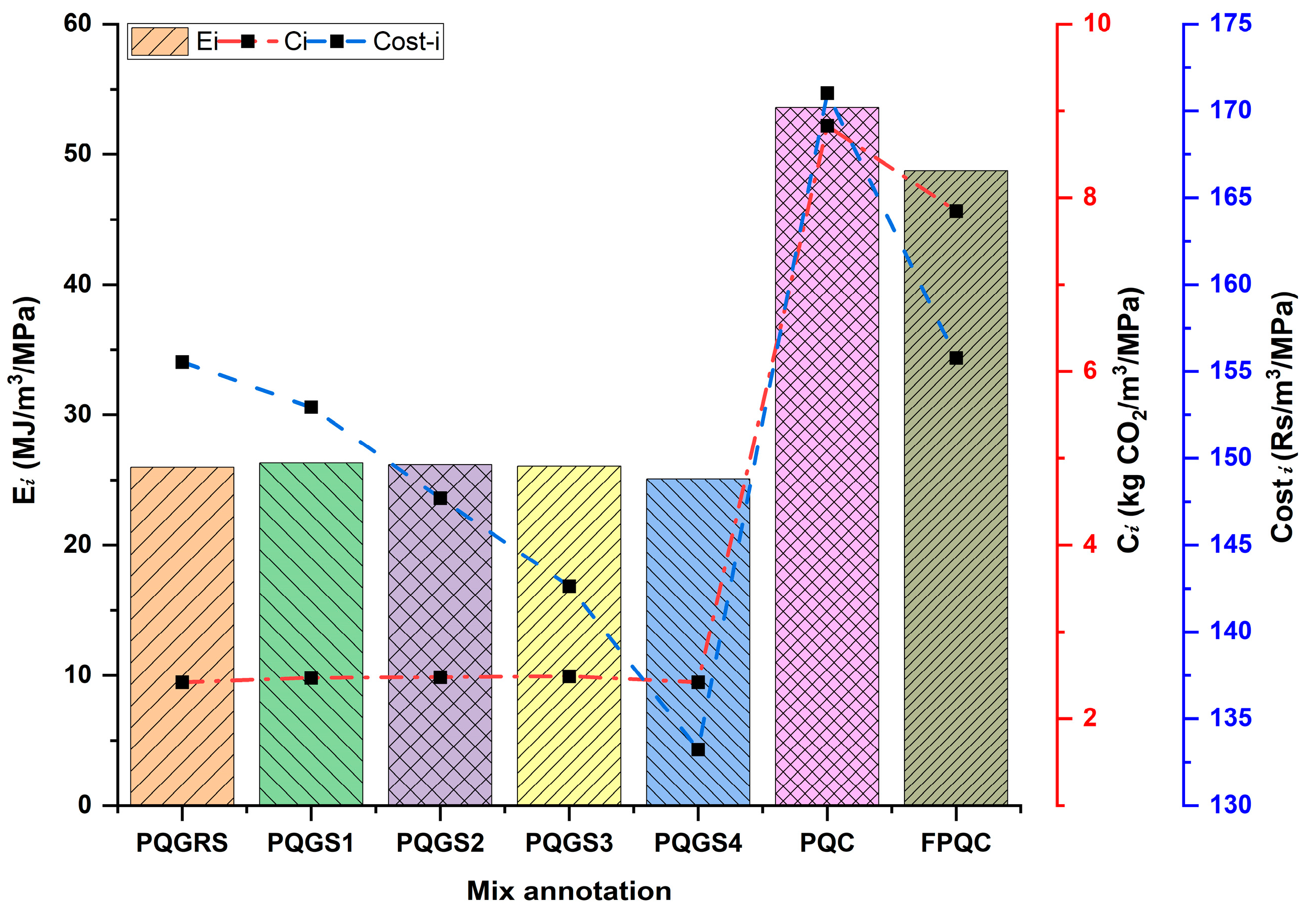
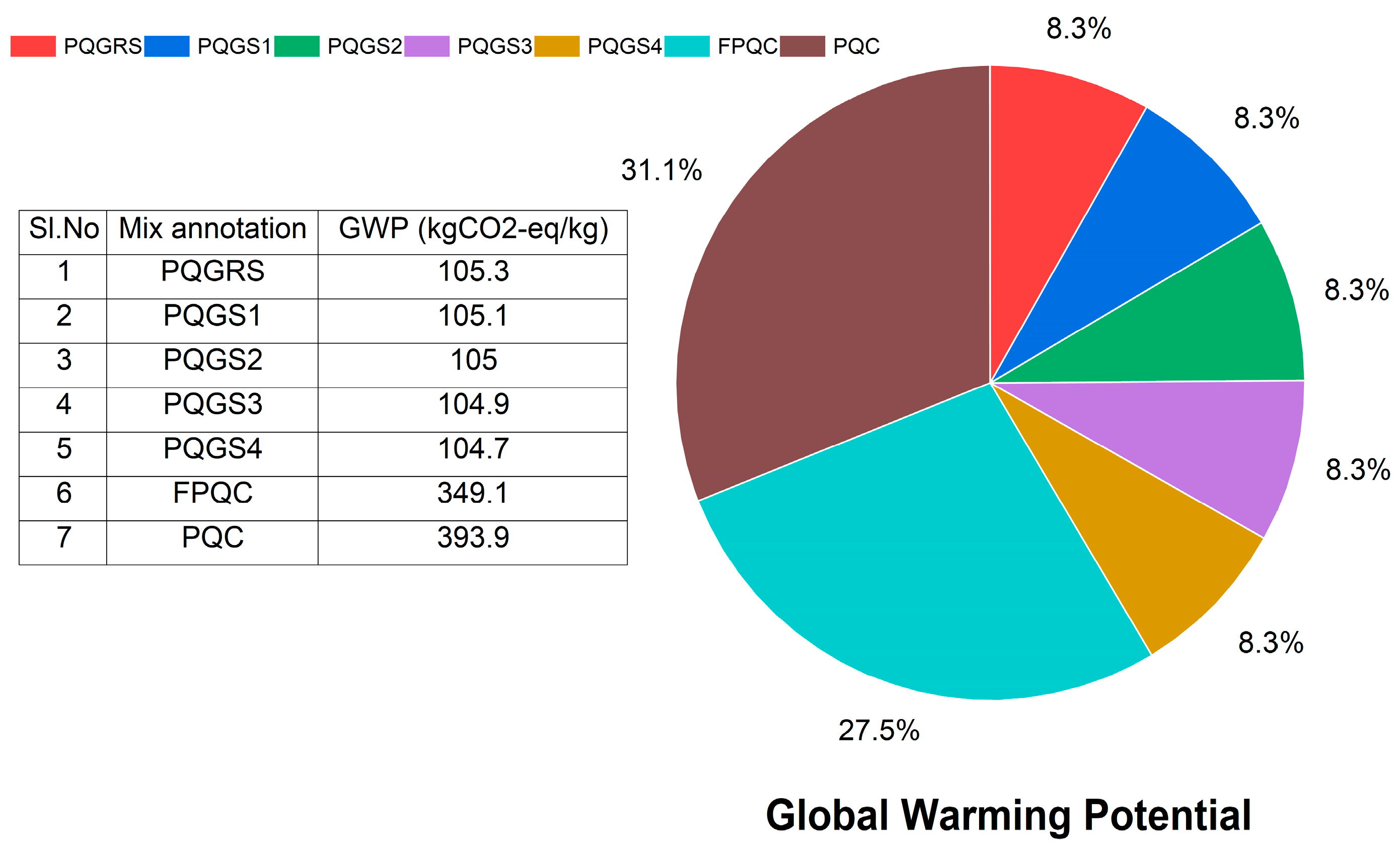
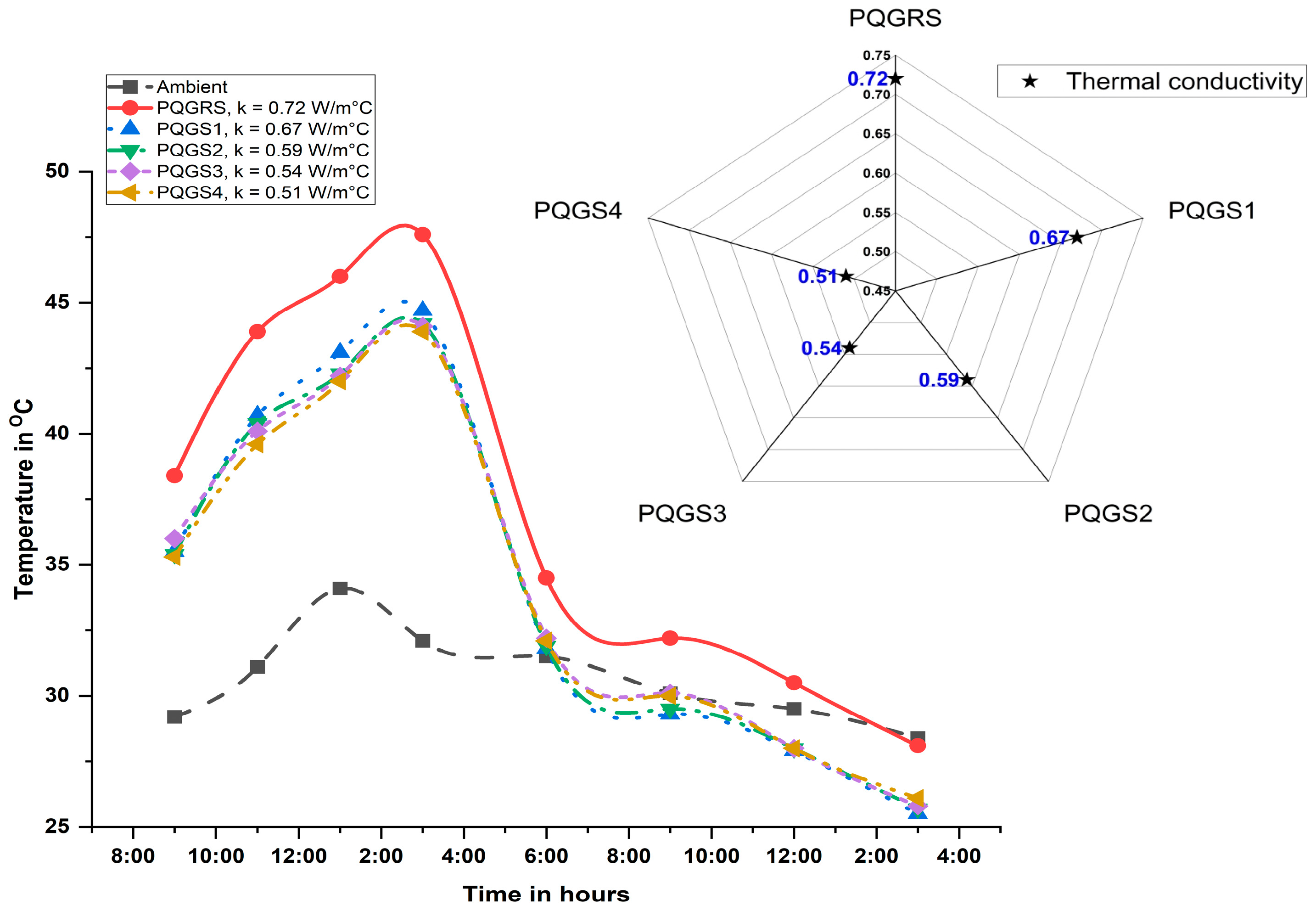
| Material | Properties | IS Code |
|---|---|---|
| FA | G = 2.3 | IS: 1727, 1967 [60] |
| GGBS | G = 2.72 | IS:1727, 1967 [60] |
| CAg | Zone II | IS: 2386-Part I, 1963 [61] |
| G = 2.72 | IS: 2386-Part III, 1963 [62] | |
| Impact value = 28% | IS: 2386-Part IV, 1963 [63] | |
| Abrasion value = 37% | ||
| Aggregate crushing value = 26% | ||
| RSa | G = 2.64 | IS: 2386-Part III, 1963 [62] |
| Grade: zone II | IS: 1727, 1967 [60] | |
| Fineness modulus = 2.93 | ||
| PSS | Grade: zone II | IS: 1727, 1967 [60] |
| Specific gravity: 2.65 | IS: 2386- Part III, 1963 [62] | |
| Fineness modulus: 3.49 | ||
| NaOH pellets | Industrial grade of 97% purity | |
| SSS | Na2O = 13.54%, SiO2 = 32.46% and H2O = 54.0% |
| Material | SiO2 | Al2O3 | TiO2 | Fe2O3 | CaO | MgO | MnO | Na2O | K2O | SO3 | LOI |
|---|---|---|---|---|---|---|---|---|---|---|---|
| FA | 51.67 | 21.62 | 1.32 | 12.7 | 3.9 | 1.2 | - | 1.97 | 1.81 | 0.66 | 2.15 |
| GGBS | 37.73 | 14.42 | - | 1.11 | 37.34 | 8.71 | 0.02 | - | - | 0.39 | 1.41 |
| PSS | 36.01 | 17.29 | - | 0.73 | 34.3 | 6.03 | - | - | - | 0.02 | - |
| Material in kg/m3 | PQGRS | PQGS1 (PSS = 25%) | PQGS-2 (PSS = 50%) | PQGS-3 (PSS = 75%) | PQGS-4 (PSS = 100%) |
|---|---|---|---|---|---|
| FA | 233.3 | 233.3 | 233.3 | 233.3 | 233.3 |
| GGBS | 100 | 100 | 100 | 100 | 100 |
| 10M SHS | 33.3 | 33.3 | 33.3 | 33.3 | 33.3 |
| SSS | 83.3 | 83.3 | 83.3 | 83.3 | 83.3 |
| CAg | 1236.2 | 1236.2 | 1236.2 | 1236.2 | 1236.2 |
| RSa | 584.3 | 438.2 | 292.1 | 146.0 | 0.0 |
| PSS | 0.0 | 146.0 | 292.1 | 438.2 | 584.3 |
| Water | 153 | 153 | 153 | 153 | 153 |
| Sl. No | Type of Test | Specimen Type | Specimen Dimension in mm | IS Code |
|---|---|---|---|---|
| 1 | Compression strength | Cube | 100 × 100 × 100 | IS: 516 Part-1/Sec-1 2021 [65] |
| 2 | Flexural strength | Beam | 500 × 100 × 100 | |
| 3 | Split tensile strength | Cylinder | Ø100 × 300 | |
| 4 | Thermal conductivity | Disc | Ø180 × 20 | IS: 3346-1980 [66] |
| Sl. No. | Material | EE in MJ/kg |
|---|---|---|
| 1 | Water | 0 |
| 2 | RSa | 0.02 |
| 3 | FA | 0.04 |
| 4 | PSS | 0.15 |
| 5 | CAg | 0.22 |
| 6 | GGBS | 0.31 |
| 7 | OPC | 4.6 |
| 8 | Na2SiO3 | 5.37 |
| 9 | Admixture | 12 |
| 10 | NaOH | 20.5 |
| Sl. No. | Material | Kg-CO2/kg |
|---|---|---|
| 1 | Water | 0 |
| 2 | RSa | 0.0048 |
| 3 | FA | 0.004 |
| 4 | PSS | 0.026 |
| 5 | CAg | 0.0048 |
| 6 | GGBS | 0.052 |
| 7 | OPC | 0.84 |
| 8 | Na2SiO3 | 0.68 |
| 9 | Admixture | 1.88 |
| 10 | NaOH | 1.915 |
| Sl. No. | Material | Indian Rupees (INR (₹))/kg |
|---|---|---|
| 1 | Water | 0 |
| 2 | RSa | 3 |
| 3 | FA | 0 |
| 4 | PSS | 2 |
| 5 | CAg | 0.74 |
| 6 | GGBS | 4.6 |
| 7 | OPC | 9 |
| 8 | Na2SiO3 | 35 |
| 9 | Admixture | 80 |
| 10 | NaOH | 80 |
Disclaimer/Publisher’s Note: The statements, opinions and data contained in all publications are solely those of the individual author(s) and contributor(s) and not of MDPI and/or the editor(s). MDPI and/or the editor(s) disclaim responsibility for any injury to people or property resulting from any ideas, methods, instructions or products referred to in the content. |
© 2024 by the authors. Licensee MDPI, Basel, Switzerland. This article is an open access article distributed under the terms and conditions of the Creative Commons Attribution (CC BY) license (https://creativecommons.org/licenses/by/4.0/).
Share and Cite
M. G., G.; Shetty, K.K.; Nayak, G.; Kamath, K. Evaluation of Mechanical, Ecological, Economical, and Thermal Characteristics of Geopolymer Concrete Containing Processed Slag Sand. Sustainability 2024, 16, 7402. https://doi.org/10.3390/su16177402
M. G. G, Shetty KK, Nayak G, Kamath K. Evaluation of Mechanical, Ecological, Economical, and Thermal Characteristics of Geopolymer Concrete Containing Processed Slag Sand. Sustainability. 2024; 16(17):7402. https://doi.org/10.3390/su16177402
Chicago/Turabian StyleM. G., Girish, Kiran K. Shetty, Gopinatha Nayak, and Kiran Kamath. 2024. "Evaluation of Mechanical, Ecological, Economical, and Thermal Characteristics of Geopolymer Concrete Containing Processed Slag Sand" Sustainability 16, no. 17: 7402. https://doi.org/10.3390/su16177402






